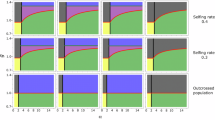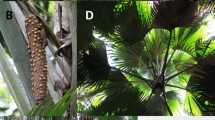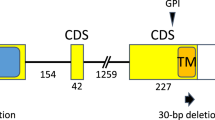Abstract
The genetic basis of male sterility in the gynodioecious species Plantago coronopus was studied. As the aim was to find strains with a single, varying nuclear locus for male sterility, cytoplasmic variation was avoided by starting with one open pollinated female. The progeny appeared to vary for a single locus with the homozygous recessive being male sterile. The locus was designated msl. Expected segregation ratios were disturbed by two different factors, both leading to a shortage of male steriles. An accidental drought in Petri dishes caused a relatively higher mortality of seedlings with a male sterility genotype in most cases. When this effect was avoided a systematic shortage of male steriles remained in many crosses. An experiment with varying levels of pollen competition justified the interpretation that selection at the gametophytic stage was involved. Pollen carrying the sterility allele was estimated to have a fertilization success relative to pollen with the restorer allele of 0.56. Finally the role of the msl locus in the genetics of male sterility in natural populations was assessed by crossing heterozygously and homozygously restored plants with male steriles collected from the wild. It appeared that the inheritance of male sterility is more complicated than the msl locus alone, which was expected. If the selection effects on the msl locus observed in this study occur in nature, this would have interesting consequences for the evolutionary dynamics of gynodioecy.
Similar content being viewed by others
Article PDF
References
Bos, M, Steen, R, and Harmens, H. 1985. Protogyny in Plantago lanceolata populations: an adaptation to pollination by wind? In: Jacquard, P., Heim, G. and Antonovics, J. (eds) Genetic Differentiation and Dispersal in Plants, Springer-Verlag, Berlin, pp. 327–338.
Charlesworth, D. 1981. A further study of the problem of the maintenance of females in gynodioecious species. Heredity, 46, 27–39.
Conn, J S, and Blum, U. 1981. Sex ratio of Rumex hastatulus: the effect of environmental factors and certation. Evolution, 35, 1108–1116.
Connor, H E, and Charlesworth, D. 1989. Genetics of male sterility in gynodioecious Cortaderia (Gramineae). Heredity, 63, 373–382.
Correns, C. 1921. Zweite Fortsetzung der Versuche zur experimentellen Verschieben des Geschlechtsver-haltnisses. Sitzungsber Preuss Akad Wiss Phys-Math Klasse, 25, 330–354.
Dowling, R E. 1933. The reproduction of Plantago coro-nopus: An example of morphological and biological seed dimorphism. Ann Bot, 47, 861–872.
Frank, S A. 1989. The evolutionary dynamics of cytoplasmic male sterility. Am Natur, 133, 345–376.
Gouyon, P H, and Couvet, D. 1985. Selfish cytoplasm and adaptation: variations in the reproductive system of thyme. In: Haeck, J. and Woldendorp, J. W. (eds) Structure and Functioning of Plant Populations 2, North Holland Publ. Co., Amsterdam, pp. 299–320.
Gouyon, P H, and Couvet, D. 1987. A conflict beween two sexes, females and hermaphrodites. In: Stearns, S.C. (ed.) The Evolution of Sex and its Consequences, Birkhauser-Verlag, Basel, pp. 245–261.
Gouyon, P H, Vichot, F, and Van Damme, J M M. 1990. Nuclear-cytoplasmic male sterility: single point equilibria versus limit cycles. Am Natur, in press.
Hossain, M A, and Driscoll, C J. 1981. Transfer of cornerstone male-sterility mutant to tetraploid wheat and hexaploid and octoploid triticales. Can J Genet Cytol, 23, 493–496.
Kaul, M L H. 1988. Male Sterility in Higher Plants. Springer-Verlag, Berlin.
Kesseli, R, and Jain, S K. 1984. An ecological genetic study of gynodioecy in Limnanthes douglasii (Limnanthaceae). Am J Bot, 71, 775–786.
Kheyr-Pour, A. 1981. Wide nucleo-cytoplasmic polymorphism for male sterility in Origanum vulgare L. J Hered, 72, 45–52.
Lewis, D, and Crowe, L K. 1956. The genetics and evolution of gynodioecy. Evolution, 10, 115–125.
Rychlewski, J, and Zarzycki, K. 1975. Sex ratio in seeds of Rumex acetosa L. as a result of sparse or abundant pollination. Acta Biol Crac Series Bot, 18, 101–114.
Snow, A A, and Mazer, S J. 1988. Gametophytic selection in Raphanus raphanistrum: a test for heritable variation in pollen competitive ability. Evolution, 42, 1065–1075.
Sokal, R R, and Rohlf, F J. 1981. Biometry. Freeman & Co, San Francisco.
Sun, M. 1987. Genetics of gynodioecy in Hawaiian Bidens (Asteraceae). Heredity, 59, 327–336.
Tonsor, S J. 1985. Intrapopulational variation in pollen-mediated gene flow in Plantago lanceolata L. Evolution, 39, 775–782.
Van Damme, J M M. 1983. Gynodioecy in Plantago lanceolata L. II. Inheritance of three male sterility types. Heredity, 50, 253–273.
Van Damme, J M M, and Van Delden, W. 1982. Gynodioecy in Plantago lanceolata L. I. Polymorphism for plasmon type. Heredity, 49, 303–318.
Van Nigtevecht, G. 1966. Genetic studies in dioecious Melandrium. I. Sex-linked and sex-influenced inheritance in Melandrium album and Melandrium dioicum. Genetica, 37, 281–306.
Author information
Authors and Affiliations
Rights and permissions
About this article
Cite this article
van Damme, J. A restorer gene in gynodioecious Plantago coronopus subject to selection in the gametophytic and seedling stage. Heredity 66, 19–27 (1991). https://doi.org/10.1038/hdy.1991.3
Received:
Issue date:
DOI: https://doi.org/10.1038/hdy.1991.3
Keywords
This article is cited by
-
The female advantage in natural populations of gynodioecious Plantago coronopus: seed quantity vs. offspring quality
Oecologia (2017)
-
Mixed genetic and environmental sex determination in an androdioecious population of Mercurialis annua
Heredity (1997)
-
Genetic systems of six species ofPlantago (Plantaginaceae)
Plant Systematics and Evolution (1992)
-
Inheritance of male sterility in Trifolium hirtum All
Genetica (1992)



